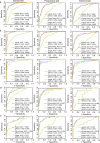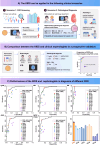A noninvasive model for chronic kidney disease screening and common pathological type identification from retinal images
- PMID: 40730556
- PMCID: PMC12307705
- DOI: 10.1038/s41467-025-62273-0
A noninvasive model for chronic kidney disease screening and common pathological type identification from retinal images
Erratum in
-
Author Correction: A noninvasive model for chronic kidney disease screening and common pathological type identification from retinal images.Nat Commun. 2025 Sep 22;16(1):8333. doi: 10.1038/s41467-025-64352-8. Nat Commun. 2025. PMID: 40983622 Free PMC article. No abstract available.
Abstract
Chronic kidney disease (CKD) is a global health challenge, but invasive renal biopsies, the gold standard for diagnosis and prognosis, are often clinically constrained. To address this, we developed the kidney intelligent diagnosis system (KIDS), a noninvasive model for renal biopsy prediction using 13,144 retinal images from 6773 participants. The KIDS achieves an area under the receiver operating characteristic curve (AUC) of 0.839-0.993 for CKD screening and accurately identifies the five most common pathological types (AUC: 0.790-0.932) in a multicenter and multi-ethnic validation, outperforming nephrologists by 26.98% in accuracy. Additionally, the KIDS further predicts disease progression based on pathological classification. Given its flexible strategy, the KIDS can be adapted to local conditions to provide a tailored tool for patients. This noninvasive model has the potential to improve CKD clinical management, particularly for those who are ineligible for biopsies.
© 2025. The Author(s).
Conflict of interest statement
Competing interests: Zhongshan Ophthalmic Center and The First Affiliated Hospital, Sun Yat-sen University have filed for patent protection for H.L., W.C., Q.W., L.Z., J.L., D.L., and J.W. for work related to noninvasive screening, diagnosis, and prognosis prediction of CKD. All other authors declare no competing interests.
Figures





References
-
- Baumann, M., Burkhardt, K. & Heemann, U. Microcirculatory marker for the prediction of renal end points: a prospective cohort study in patients with chronic kidney disease stage 2 to 4. Hypertension64, 338–346 (2014). - PubMed
-
- Kidney Disease: Improving Global Outcomes (KDIGO) CKD Work Group. KDIGO 2024 Clinical Practice Guideline for the evaluation and management of chronic kidney disease. Kidney Int.105, S117–S314 (2024). - PubMed
-
- Levey, A. S. & Coresh, J. Chronic kidney disease. Lancet. 379, 165–180 (2012). - PubMed
Publication types
MeSH terms
Grants and funding
LinkOut - more resources
Full Text Sources
Medical

